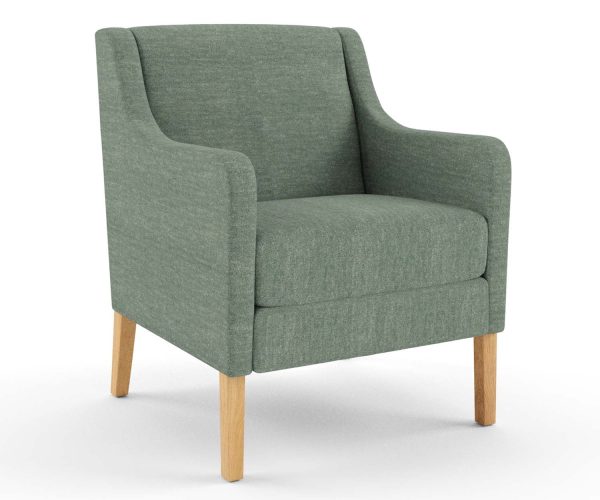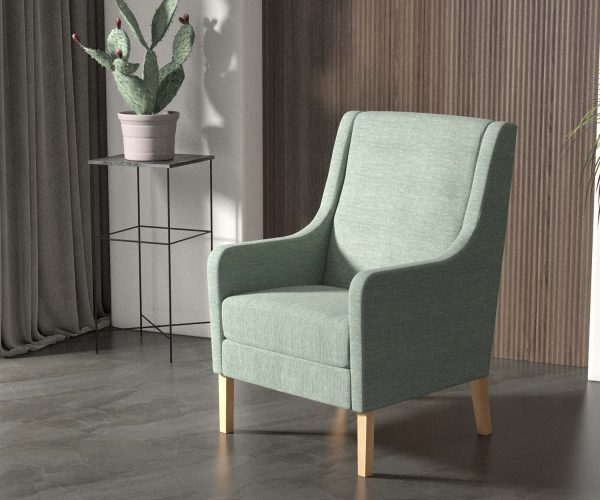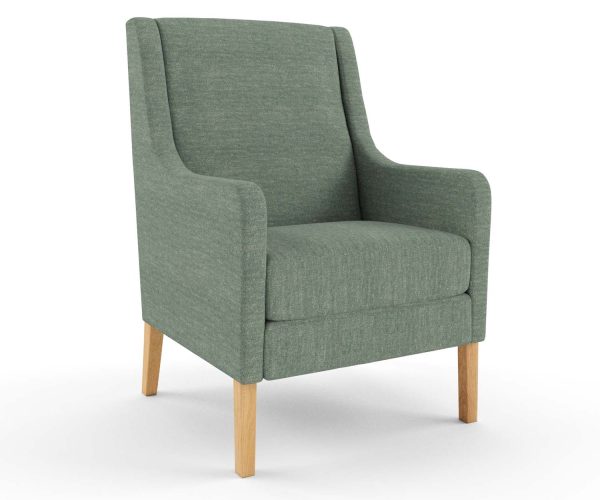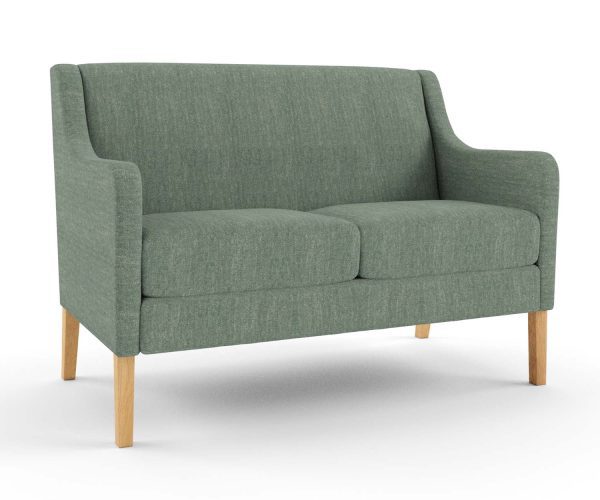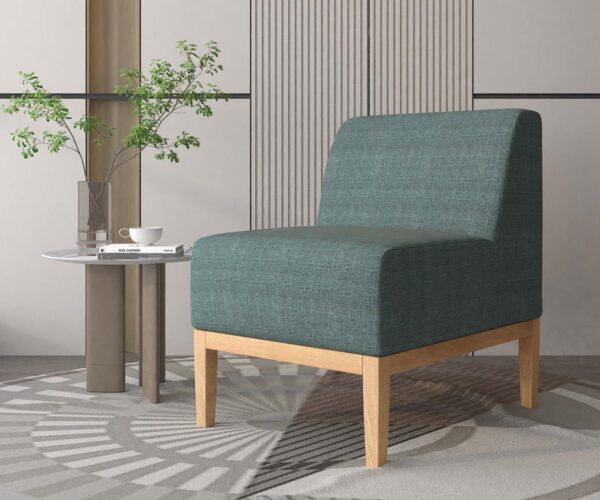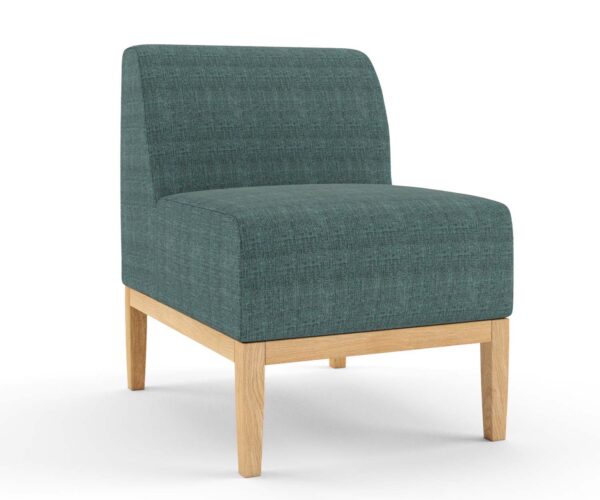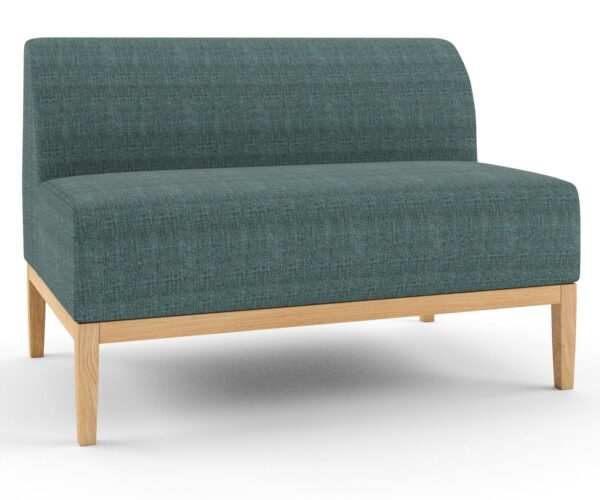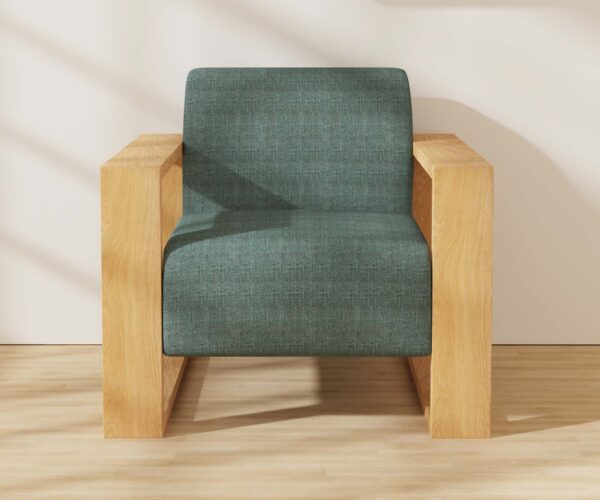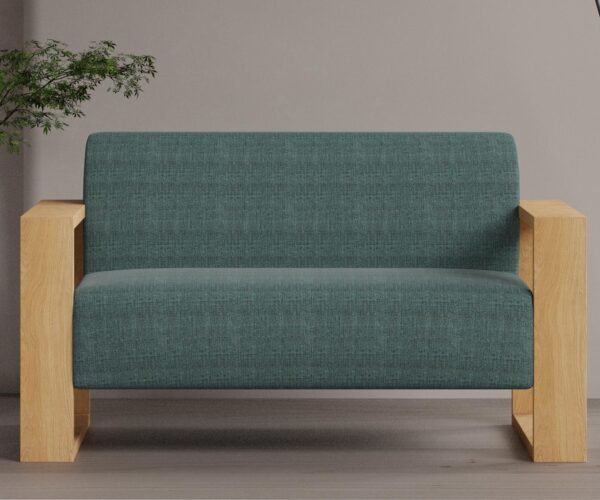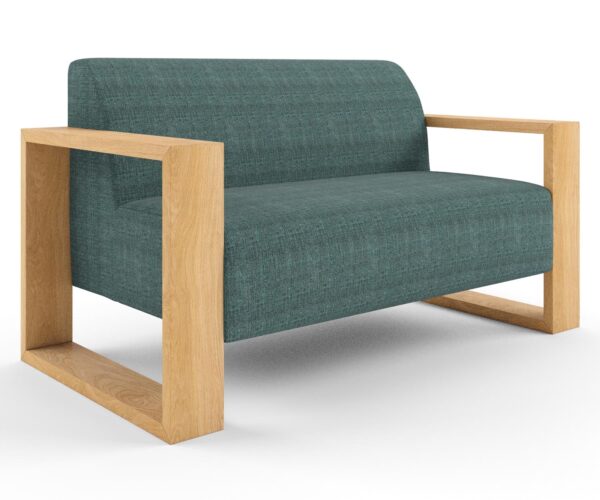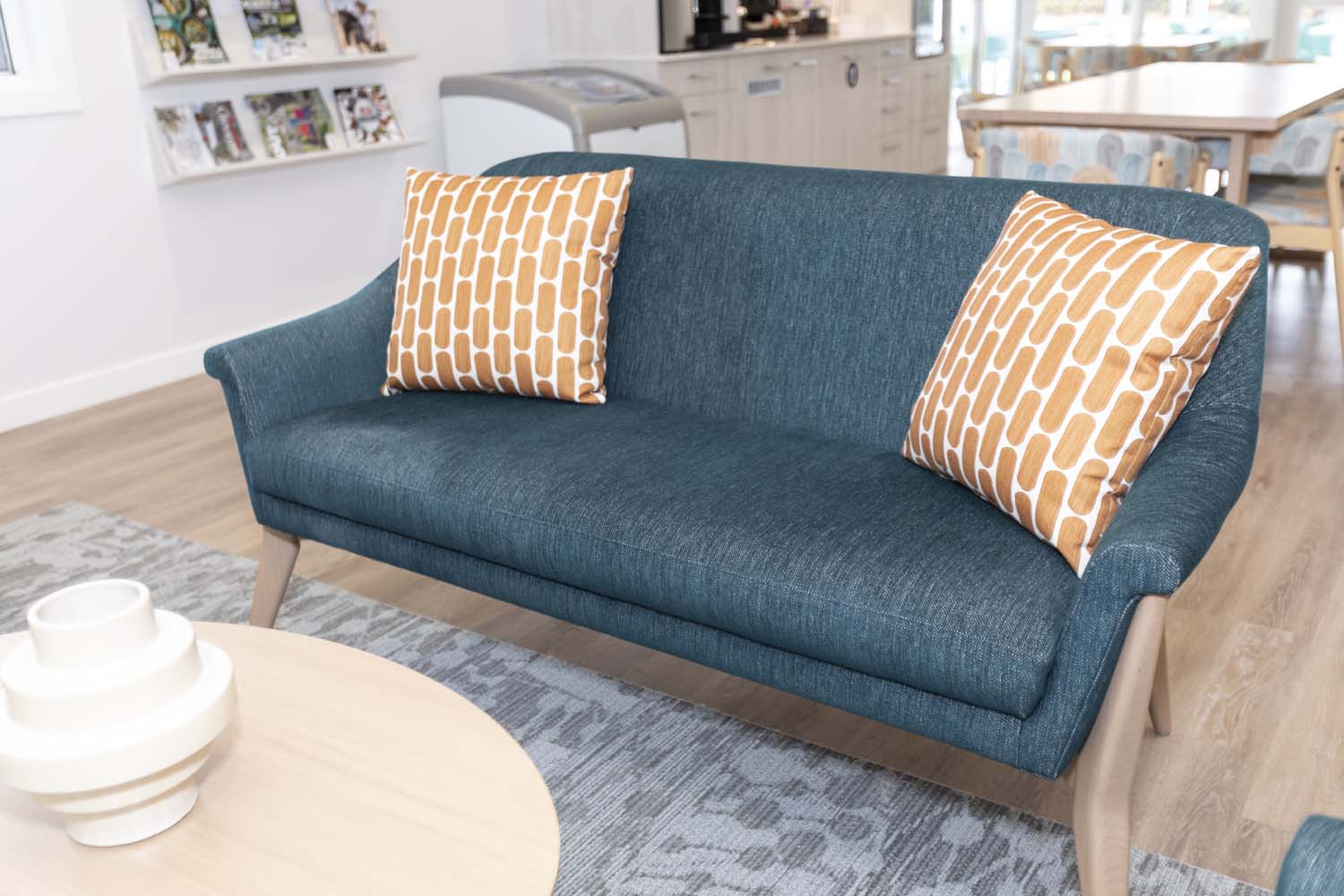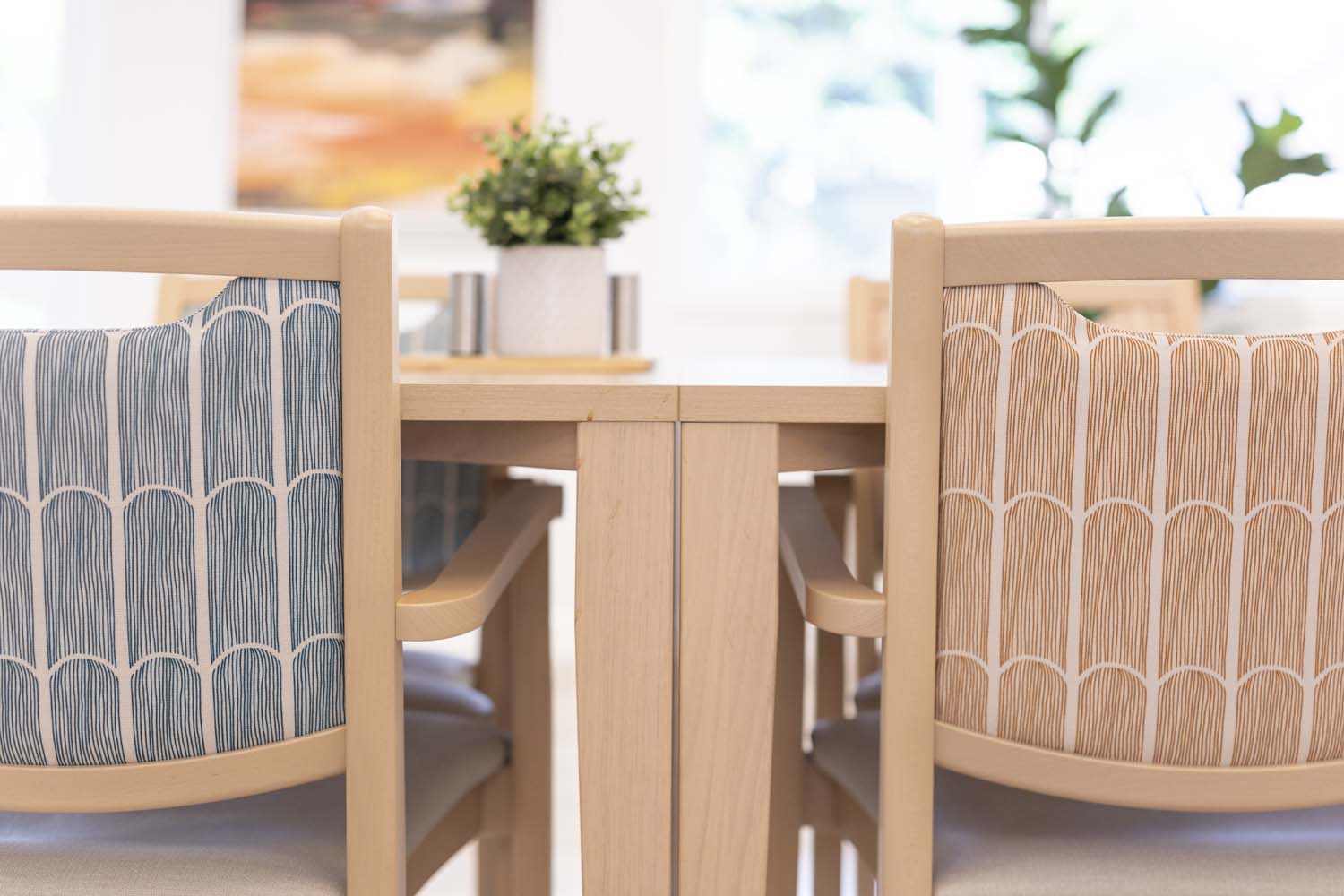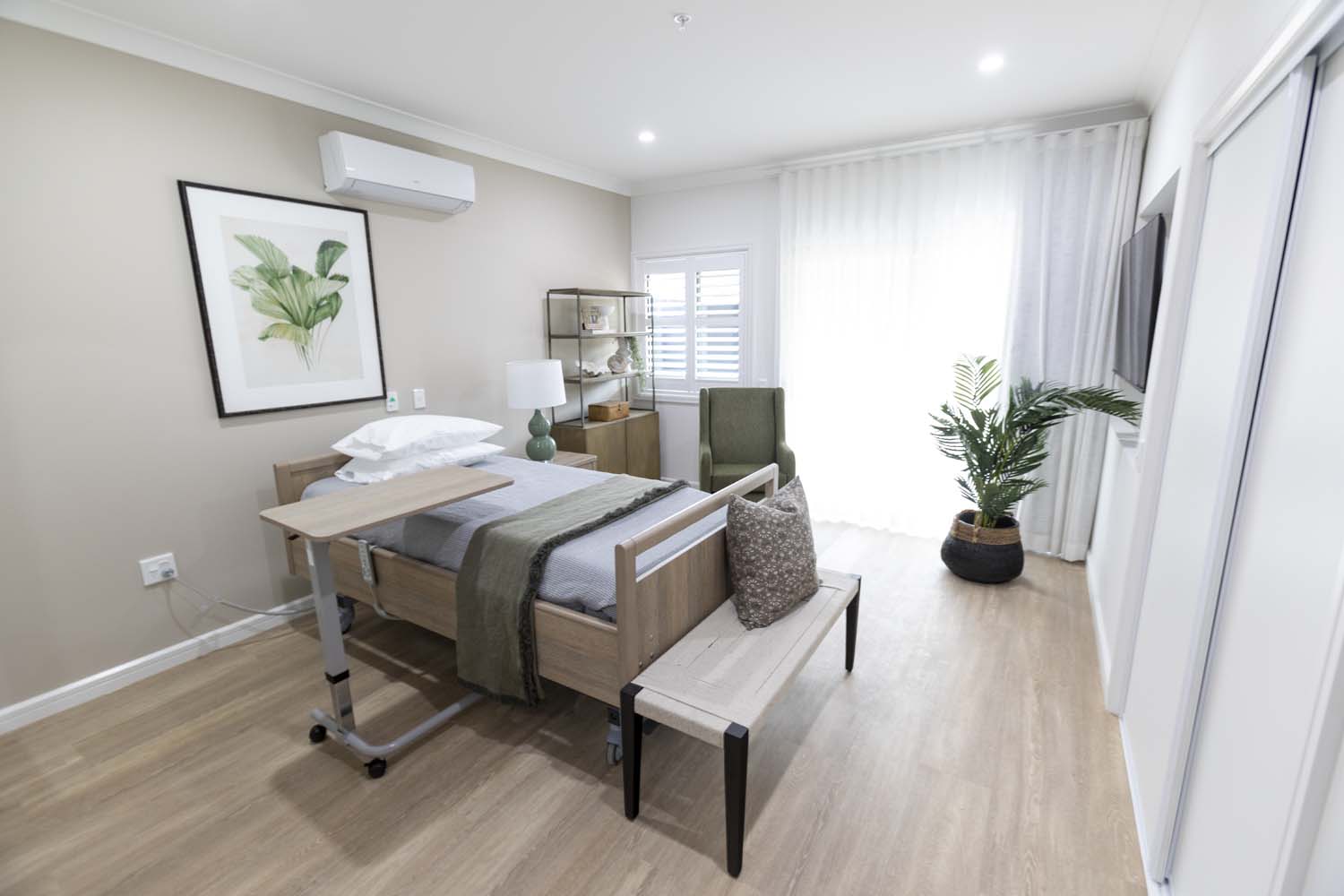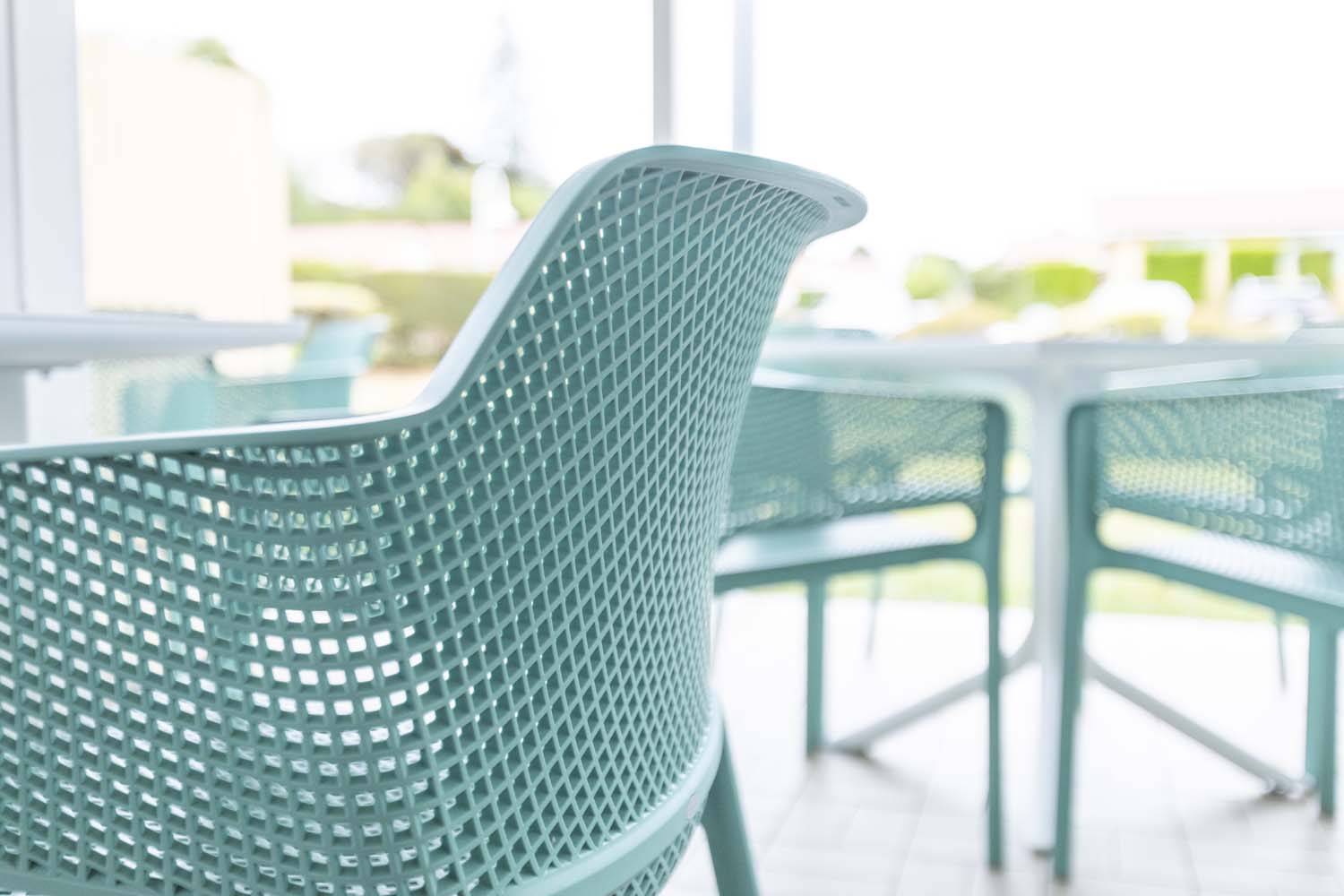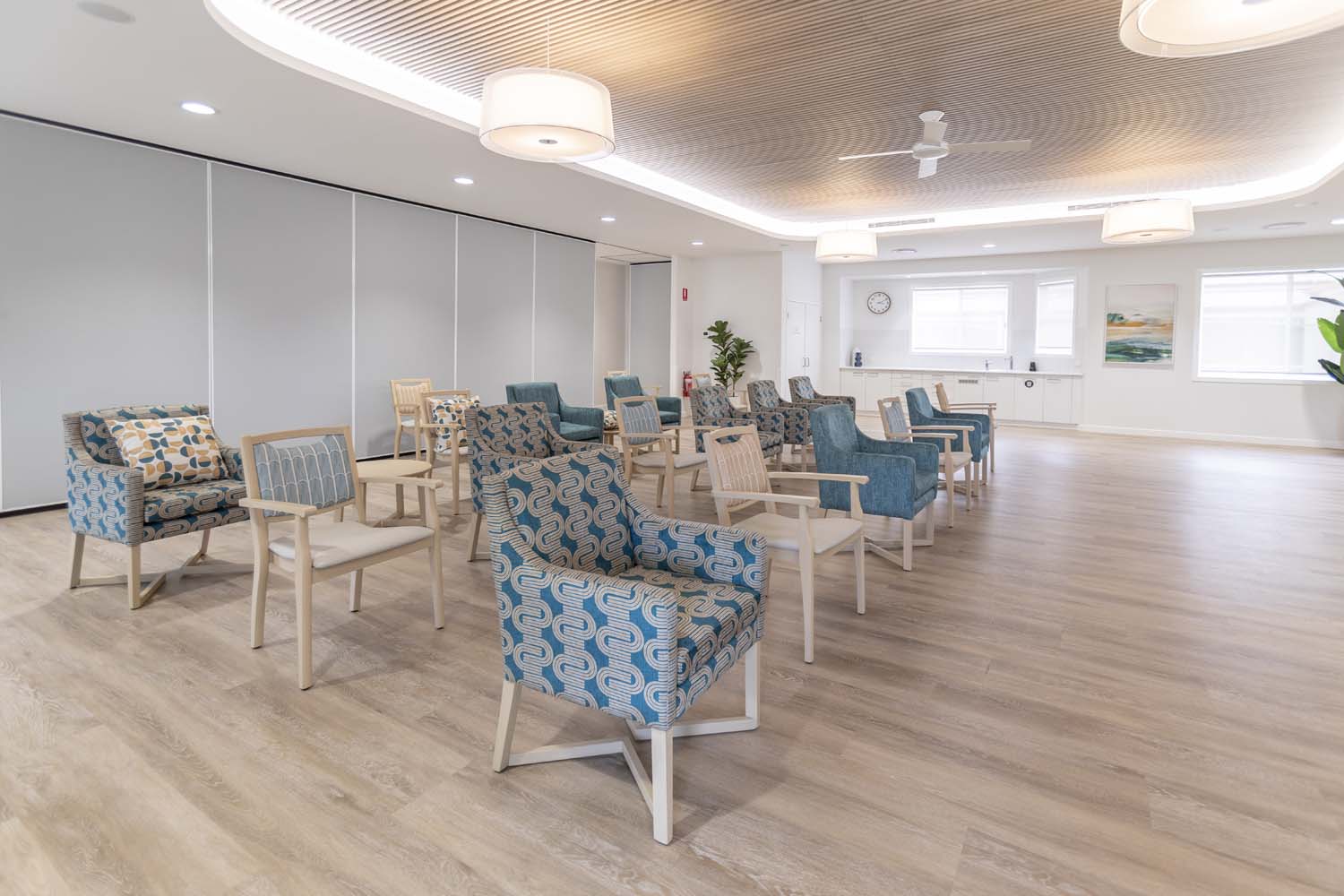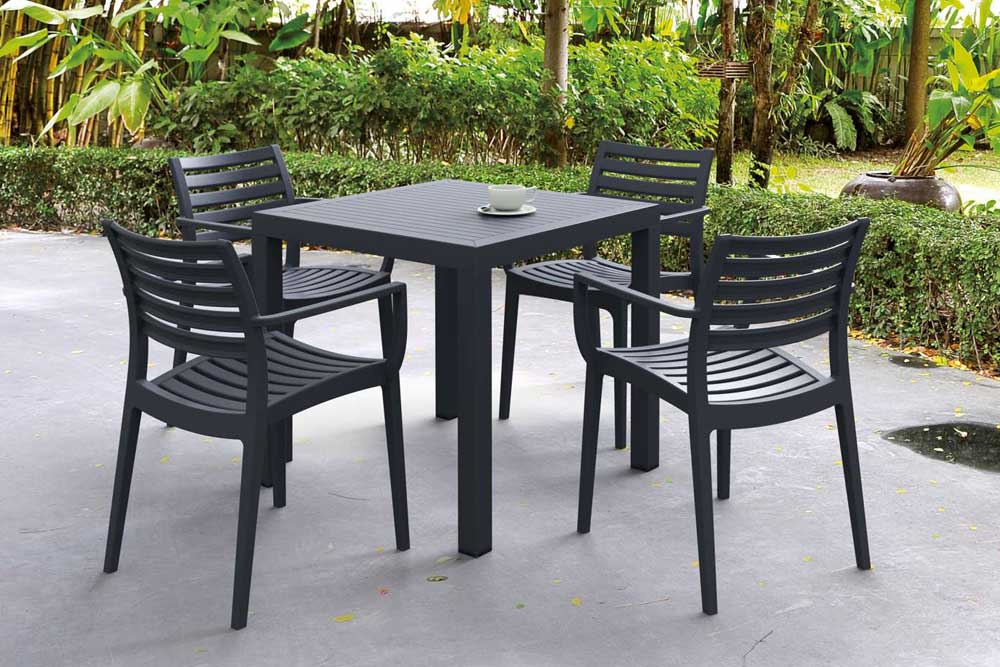Furniture FAQs: Answers to the 10 Most Common Questions from Aged Care Facility Managers
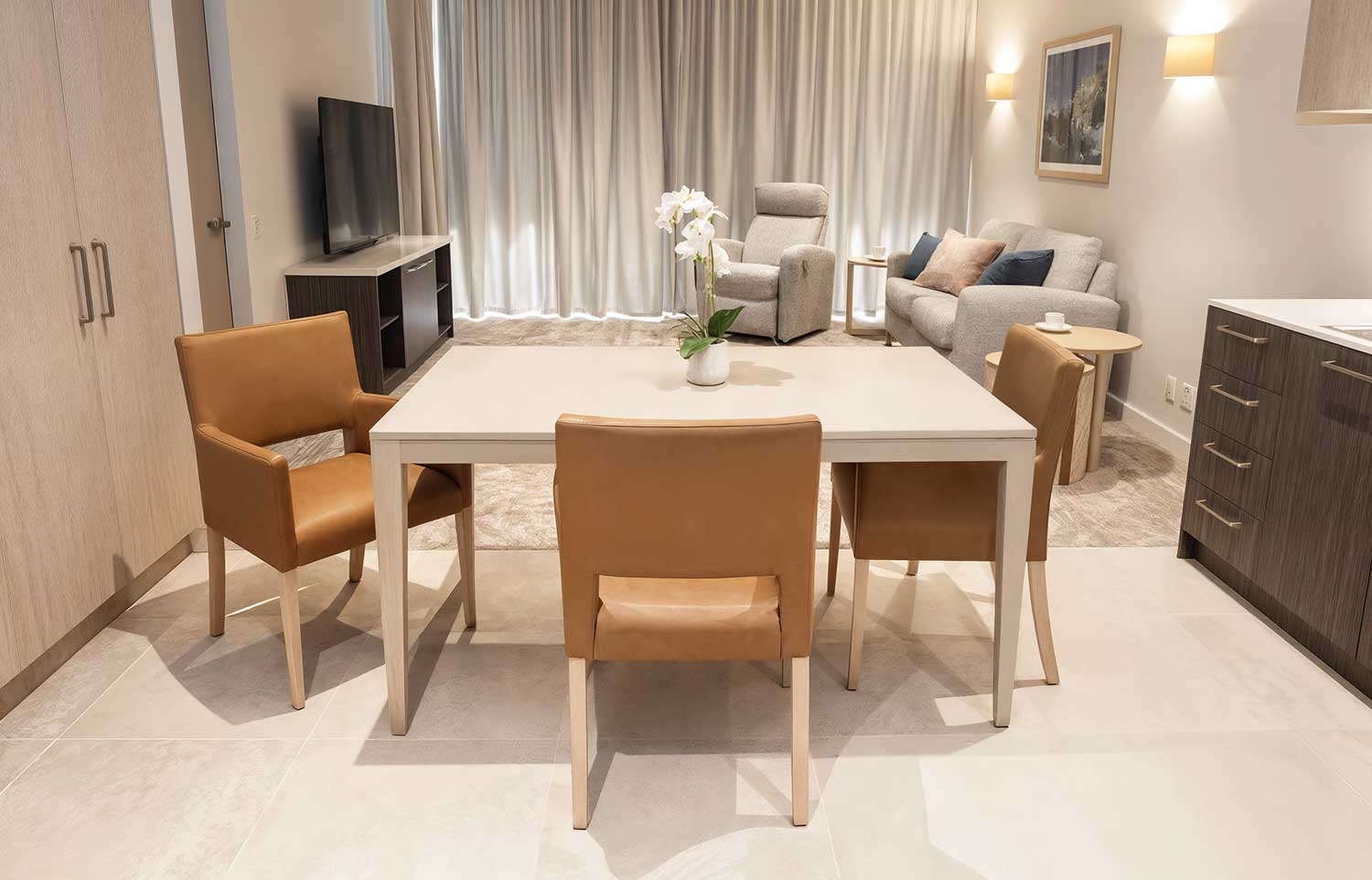
Furniture procurement in aged care isn’t just about choosing something that looks good in a room. It’s about safety, compliance, comfort, longevity, and resident wellbeing. After working with aged care providers across Australia, we’ve noticed the same questions come up again and again.
In this article, we’ve answered the 10 most common furniture questions from aged care facility managers—offering practical guidance to support your next fitout or refurbishment project.
1. What’s the best type of chair for immobile residents?
When selecting chairs for immobile residents, comfort and safety are paramount. The ideal chair should support ease of transfer, promote good posture, and minimise the risk of pressure injuries. Look for features like sturdy armrests, high seat height (typically 480–520mm), firm pressure-relief cushioning, and non-slip feet or lockable castors. Upholstery should be durable, easy to clean, and suitable for clinical environments. Choosing the right chair can improve both resident wellbeing and staff safety during daily care routines.
Chairs for residents with limited mobility should:
-
Have armrests to assist with transfers
-
Feature firm, supportive cushions to reduce pressure injuries
-
Be at a suitable height (often 480–520mm seat height)
-
Include non-slip feet or lockable castors
-
Use pressure-care foam for extended sitting
👉 Need more detail? See our guide: Evidence-based Recommendations for Aged Care Chair Design
2. How do I clean aged care furniture upholstery?
Cleaning aged care furniture upholstery is essential for maintaining hygiene, preventing the spread of infection, and prolonging the life of the furniture. Upholstery in aged care settings is typically made from healthcare-grade fabrics or vinyls designed to withstand regular cleaning with mild detergents and disinfectants. It’s important to follow manufacturer guidelines, avoid harsh chemicals like bleach unless approved, and focus on high-touch areas such as armrests and seat backs. Regular maintenance not only ensures a clean environment for residents and staff but also helps furniture maintain its appearance and integrity over time.
Cleaning depends on the fabric, but generally:
-
Vinyls and healthcare-grade fabrics can be cleaned with neutral detergents and disinfectants (check the manufacturer’s guide)
-
Avoid harsh chemicals like bleach unless approved
-
Use a soft cloth, not abrasives
-
Regularly clean arms and headrests—these are high-contact zones
For deep cleaning, work with professional soft furnishing cleaners who understand infection control in aged care.
3. Can we reupholster instead of replacing our furniture?
Reupholstering aged care furniture can be a smart, cost-effective alternative to full replacement—especially when the existing frames are still structurally sound. It allows facilities to refresh tired or outdated pieces, update fabric selections to match new interiors, and meet current compliance standards without starting from scratch. However, it’s essential to work with a commercial furniture supplier experienced in aged care settings to ensure that reupholstered items use appropriate materials, including fire-retardant and easy-to-clean fabrics, and maintain overall safety and durability.
Reupholstering is only an option if:
-
The furniture frame is structurally sound
-
It was originally a commercial-grade product
-
You’re using a supplier who understands aged care compliance (e.g. fire retardancy, cleanability)
Reupholstery is a cost-effective way to extend the life of well-built furniture and update colours to suit a renovation.
4. How long should aged care furniture last?
Aged care furniture is a significant investment, so it’s important to understand how long it should realistically last under daily use in a care environment. While quality furniture designed for aged care settings can offer 10 or more years of structural durability, upholstered surfaces typically need refreshing or replacing every 5 to 8 years, depending on usage, cleaning practices, and the materials used. Choosing commercial-grade furniture with robust frames, performance fabrics, and a strong warranty can extend the lifespan of your assets and reduce long-term replacement costs.
With the right product, you should expect:
-
10+ years structural integrity (especially if backed by warranty)
-
5–8 years for upholstered surfaces, depending on usage and cleaning
Furniture that wears out earlier may not have been designed for commercial care settings.
👉 Related post: The Real Reason Your Healthcare Furniture Isn’t Lasting: What Manufacturers Don’t Want You to Know
5. Can we get furniture customised to our specific needs?
Absolutely—customised furniture is often the best way to ensure a perfect fit for your residents, staff, and spaces. In aged care, customisation can mean adjusting seat heights for mobility support, selecting dementia-friendly fabrics and colours, or modifying dimensions to suit smaller rooms or awkward layouts. It also allows you to maintain consistency with your facility’s design scheme while meeting functional and clinical requirements. Partnering with a supplier who understands aged care ensures that custom pieces remain compliant with safety and infection control standards, while still supporting resident comfort and dignity.
Customisation options often include:
-
Seat height and width
-
Timber stain or fabric choices
-
Waterproofing or pressure-relief upgrades
-
Bariatric or dementia-friendly adaptations
-
Fitted dimensions for awkward spaces
Work with a supplier who offers made-to-order commercial furniture, not just off-the-shelf options.
6. What’s the typical lead time for ordering aged care furniture?
Lead times for aged care furniture can vary significantly depending on the type of product, level of customisation, and whether it’s locally made or imported. On average, Australian-made, made-to-order items take around 4–6 weeks from order to delivery, while imported or highly customised pieces may require 8–12 weeks or more. Understanding these timelines is essential for project planning, particularly when coordinating with builders, fitout schedules, or resident move-ins. Engaging suppliers early and confirming lead times upfront can help avoid costly delays and ensure a smoother installation process.
Standard lead times are:
-
4–6 weeks for made-to-order Australian-made items
-
8–12+ weeks for imported or highly customised products
If you’re working to a project schedule, order early and check that delivery and installation align with your builder or fitout team.
7. What furniture items should we prioritise in a tight budget?
When working within a tight budget, it’s essential to prioritise furniture that directly impacts resident comfort, safety, and daily care routines. High-use items like lounge chairs, dining chairs with arms, and pressure-relieving beds should come first, as these support mobility, wellbeing, and staff efficiency. Investing in durable, fit-for-purpose pieces in these categories can help avoid future replacement costs and ensure your facility continues to meet care standards, even when resources are limited.
Focus first on:
-
Resident seating (lounge chairs, dining chairs with arms)
-
Mattresses and beds
-
Lift/recline or comfort chairs for long-term use
Optional or decorative items (e.g. coffee tables, cushions, display shelving) can be staged over time.
👉 Further reading: Furniture Manufacturer Secrets: 6 Strategies to Stretch Your Aged Care Procurement Budget Without Sacrificing Quality
8. How can we make furniture more dementia-friendly?
Designing dementia-friendly furniture is about more than just comfort—it’s about supporting orientation, independence, and a sense of safety for residents living with cognitive impairment. Key considerations include using high-contrast colours to help residents distinguish furniture from floors and walls, avoiding reflective or glass surfaces, choosing familiar and homely designs, and ensuring pieces are stable, easy to grip, and free of sharp edges. By incorporating these elements, aged care facilities can create more supportive, calming environments that reduce confusion and promote confidence in daily living.
Choose furniture that:
-
Offers clear visual contrast with walls and flooring
-
Has recognisable, homely forms
-
Is stable and easy to grip
-
Avoids glass, sharp corners, or low-contrast finishes
-
Uses familiar textures and colours for reassurance
Adding memory cues like photo frames or display shelving also supports orientation.
👉 More on this topic: Designing with Purpose: A Furniture Checklist for Dementia-Friendly Environments
9. How do I manage furniture replacement across the whole facility?
Managing furniture replacement across an aged care facility can feel overwhelming, but a structured, phased approach makes it manageable and cost-effective. Rather than replacing everything at once, many facility managers adopt a rolling replacement strategy—prioritising high-use or high-risk items like lounge and dining chairs, then upgrading room by room or wing by wing over time. Keeping a detailed asset register with warranty dates and condition reports helps you track what needs attention and plan budget allocations annually, ensuring resident comfort and safety without blowing your capital works budget.
Try a rolling replacement plan:
-
Start with high-use or high-risk items (e.g. lounge chairs, dining chairs)
-
Break upgrades into zones (wings, floors, communal areas)
-
Track warranties and age of items with an asset register
-
Budget annually for replacements or reupholstery
This avoids major capital spend every few years and keeps resident spaces fresh and safe.
10. What information should I get from a supplier before placing an order?
Before placing an order, it’s essential to gather comprehensive information from your furniture supplier to ensure the products meet your facility’s needs and compliance requirements. This includes detailed specifications such as dimensions, materials used, and relevant compliance certifications. Understanding warranty terms, delivery schedules, installation processes, and payment conditions will help you avoid surprises down the track. Additionally, requesting fabric and finish samples allows you to assess suitability and aesthetics firsthand. Clear communication about post-sale support and reorder procedures ensures a smooth long-term partnership, helping maintain your facility’s furniture standards over time.
Ask for:
-
Full specifications (dimensions, materials, compliance certificates)
-
Warranty terms (preferably 5–10 years for structure)
-
Fabric and polish samples
-
Delivery and installation details
-
Lead times and payment terms
-
Post-sale support and reordering process
👉 Read next: What Your Furniture Supplier Should Be Doing for You: A 2025 Health and Aged Care Procurement Checklist
Final Thoughts
The right furniture choices can improve safety, comfort, and resident satisfaction in your facility. Whether you’re replacing one chair or fitting out an entire wing, having the right information makes all the difference.
Have more questions we didn’t answer here? Contact our team or explore our other articles to keep your facility looking great—and functioning even better.
Custom, Safe and Supportive Furniture for Residential Aged Care
More News
Furniture FAQs: Answers to the 10 Most Common Questions from Aged Care Facility Managers

Furniture procurement in aged care isn’t just about choosing something that looks good in a room. It’s about safety, compliance, comfort, longevity, and resident wellbeing. After working with aged care providers across Australia, we’ve noticed the same questions come up again and again.
In this article, we’ve answered the 10 most common furniture questions from aged care facility managers—offering practical guidance to support your next fitout or refurbishment project.
1. What’s the best type of chair for immobile residents?
When selecting chairs for immobile residents, comfort and safety are paramount. The ideal chair should support ease of transfer, promote good posture, and minimise the risk of pressure injuries. Look for features like sturdy armrests, high seat height (typically 480–520mm), firm pressure-relief cushioning, and non-slip feet or lockable castors. Upholstery should be durable, easy to clean, and suitable for clinical environments. Choosing the right chair can improve both resident wellbeing and staff safety during daily care routines.
Chairs for residents with limited mobility should:
-
Have armrests to assist with transfers
-
Feature firm, supportive cushions to reduce pressure injuries
-
Be at a suitable height (often 480–520mm seat height)
-
Include non-slip feet or lockable castors
-
Use pressure-care foam for extended sitting
👉 Need more detail? See our guide: Evidence-based Recommendations for Aged Care Chair Design
2. How do I clean aged care furniture upholstery?
Cleaning aged care furniture upholstery is essential for maintaining hygiene, preventing the spread of infection, and prolonging the life of the furniture. Upholstery in aged care settings is typically made from healthcare-grade fabrics or vinyls designed to withstand regular cleaning with mild detergents and disinfectants. It’s important to follow manufacturer guidelines, avoid harsh chemicals like bleach unless approved, and focus on high-touch areas such as armrests and seat backs. Regular maintenance not only ensures a clean environment for residents and staff but also helps furniture maintain its appearance and integrity over time.
Cleaning depends on the fabric, but generally:
-
Vinyls and healthcare-grade fabrics can be cleaned with neutral detergents and disinfectants (check the manufacturer’s guide)
-
Avoid harsh chemicals like bleach unless approved
-
Use a soft cloth, not abrasives
-
Regularly clean arms and headrests—these are high-contact zones
For deep cleaning, work with professional soft furnishing cleaners who understand infection control in aged care.
3. Can we reupholster instead of replacing our furniture?
Reupholstering aged care furniture can be a smart, cost-effective alternative to full replacement—especially when the existing frames are still structurally sound. It allows facilities to refresh tired or outdated pieces, update fabric selections to match new interiors, and meet current compliance standards without starting from scratch. However, it’s essential to work with a commercial furniture supplier experienced in aged care settings to ensure that reupholstered items use appropriate materials, including fire-retardant and easy-to-clean fabrics, and maintain overall safety and durability.
Reupholstering is only an option if:
-
The furniture frame is structurally sound
-
It was originally a commercial-grade product
-
You’re using a supplier who understands aged care compliance (e.g. fire retardancy, cleanability)
Reupholstery is a cost-effective way to extend the life of well-built furniture and update colours to suit a renovation.
4. How long should aged care furniture last?
Aged care furniture is a significant investment, so it’s important to understand how long it should realistically last under daily use in a care environment. While quality furniture designed for aged care settings can offer 10 or more years of structural durability, upholstered surfaces typically need refreshing or replacing every 5 to 8 years, depending on usage, cleaning practices, and the materials used. Choosing commercial-grade furniture with robust frames, performance fabrics, and a strong warranty can extend the lifespan of your assets and reduce long-term replacement costs.
With the right product, you should expect:
-
10+ years structural integrity (especially if backed by warranty)
-
5–8 years for upholstered surfaces, depending on usage and cleaning
Furniture that wears out earlier may not have been designed for commercial care settings.
👉 Related post: The Real Reason Your Healthcare Furniture Isn’t Lasting: What Manufacturers Don’t Want You to Know
5. Can we get furniture customised to our specific needs?
Absolutely—customised furniture is often the best way to ensure a perfect fit for your residents, staff, and spaces. In aged care, customisation can mean adjusting seat heights for mobility support, selecting dementia-friendly fabrics and colours, or modifying dimensions to suit smaller rooms or awkward layouts. It also allows you to maintain consistency with your facility’s design scheme while meeting functional and clinical requirements. Partnering with a supplier who understands aged care ensures that custom pieces remain compliant with safety and infection control standards, while still supporting resident comfort and dignity.
Customisation options often include:
-
Seat height and width
-
Timber stain or fabric choices
-
Waterproofing or pressure-relief upgrades
-
Bariatric or dementia-friendly adaptations
-
Fitted dimensions for awkward spaces
Work with a supplier who offers made-to-order commercial furniture, not just off-the-shelf options.
6. What’s the typical lead time for ordering aged care furniture?
Lead times for aged care furniture can vary significantly depending on the type of product, level of customisation, and whether it’s locally made or imported. On average, Australian-made, made-to-order items take around 4–6 weeks from order to delivery, while imported or highly customised pieces may require 8–12 weeks or more. Understanding these timelines is essential for project planning, particularly when coordinating with builders, fitout schedules, or resident move-ins. Engaging suppliers early and confirming lead times upfront can help avoid costly delays and ensure a smoother installation process.
Standard lead times are:
-
4–6 weeks for made-to-order Australian-made items
-
8–12+ weeks for imported or highly customised products
If you’re working to a project schedule, order early and check that delivery and installation align with your builder or fitout team.
7. What furniture items should we prioritise in a tight budget?
When working within a tight budget, it’s essential to prioritise furniture that directly impacts resident comfort, safety, and daily care routines. High-use items like lounge chairs, dining chairs with arms, and pressure-relieving beds should come first, as these support mobility, wellbeing, and staff efficiency. Investing in durable, fit-for-purpose pieces in these categories can help avoid future replacement costs and ensure your facility continues to meet care standards, even when resources are limited.
Focus first on:
-
Resident seating (lounge chairs, dining chairs with arms)
-
Mattresses and beds
-
Lift/recline or comfort chairs for long-term use
Optional or decorative items (e.g. coffee tables, cushions, display shelving) can be staged over time.
👉 Further reading: Furniture Manufacturer Secrets: 6 Strategies to Stretch Your Aged Care Procurement Budget Without Sacrificing Quality
8. How can we make furniture more dementia-friendly?
Designing dementia-friendly furniture is about more than just comfort—it’s about supporting orientation, independence, and a sense of safety for residents living with cognitive impairment. Key considerations include using high-contrast colours to help residents distinguish furniture from floors and walls, avoiding reflective or glass surfaces, choosing familiar and homely designs, and ensuring pieces are stable, easy to grip, and free of sharp edges. By incorporating these elements, aged care facilities can create more supportive, calming environments that reduce confusion and promote confidence in daily living.
Choose furniture that:
-
Offers clear visual contrast with walls and flooring
-
Has recognisable, homely forms
-
Is stable and easy to grip
-
Avoids glass, sharp corners, or low-contrast finishes
-
Uses familiar textures and colours for reassurance
Adding memory cues like photo frames or display shelving also supports orientation.
👉 More on this topic: Designing with Purpose: A Furniture Checklist for Dementia-Friendly Environments
9. How do I manage furniture replacement across the whole facility?
Managing furniture replacement across an aged care facility can feel overwhelming, but a structured, phased approach makes it manageable and cost-effective. Rather than replacing everything at once, many facility managers adopt a rolling replacement strategy—prioritising high-use or high-risk items like lounge and dining chairs, then upgrading room by room or wing by wing over time. Keeping a detailed asset register with warranty dates and condition reports helps you track what needs attention and plan budget allocations annually, ensuring resident comfort and safety without blowing your capital works budget.
Try a rolling replacement plan:
-
Start with high-use or high-risk items (e.g. lounge chairs, dining chairs)
-
Break upgrades into zones (wings, floors, communal areas)
-
Track warranties and age of items with an asset register
-
Budget annually for replacements or reupholstery
This avoids major capital spend every few years and keeps resident spaces fresh and safe.
10. What information should I get from a supplier before placing an order?
Before placing an order, it’s essential to gather comprehensive information from your furniture supplier to ensure the products meet your facility’s needs and compliance requirements. This includes detailed specifications such as dimensions, materials used, and relevant compliance certifications. Understanding warranty terms, delivery schedules, installation processes, and payment conditions will help you avoid surprises down the track. Additionally, requesting fabric and finish samples allows you to assess suitability and aesthetics firsthand. Clear communication about post-sale support and reorder procedures ensures a smooth long-term partnership, helping maintain your facility’s furniture standards over time.
Ask for:
-
Full specifications (dimensions, materials, compliance certificates)
-
Warranty terms (preferably 5–10 years for structure)
-
Fabric and polish samples
-
Delivery and installation details
-
Lead times and payment terms
-
Post-sale support and reordering process
👉 Read next: What Your Furniture Supplier Should Be Doing for You: A 2025 Health and Aged Care Procurement Checklist
Final Thoughts
The right furniture choices can improve safety, comfort, and resident satisfaction in your facility. Whether you’re replacing one chair or fitting out an entire wing, having the right information makes all the difference.
Have more questions we didn’t answer here? Contact our team or explore our other articles to keep your facility looking great—and functioning even better.
Custom, Safe and Supportive Furniture for Residential Aged Care
Commercial furniture by room
Based in Brisbane, we’re an Australian manufacturer of aged care furniture, retirement living furniture, hospital & healthcare furniture, hotel & accommodation furniture and student accommodation furniture. We also supply a range of commercial office furniture.
Discover the FHG Look Book: Your Source of Inspiration for Quality Australian-Made Commercial Furniture
- Quality Craftsmanship: See why we’ve been a trusted partner for over 25 years.
- Local Excellence: Learn how our Brisbane team ensures the highest standards.
- Inspiration and Ideas: Find innovative furniture solutions for any environment.
Don’t miss the opportunity to transform your commercial space with FHG’s expertly crafted furniture. Download the FHG Look Book today and start your journey towards exceptional design and quality.


